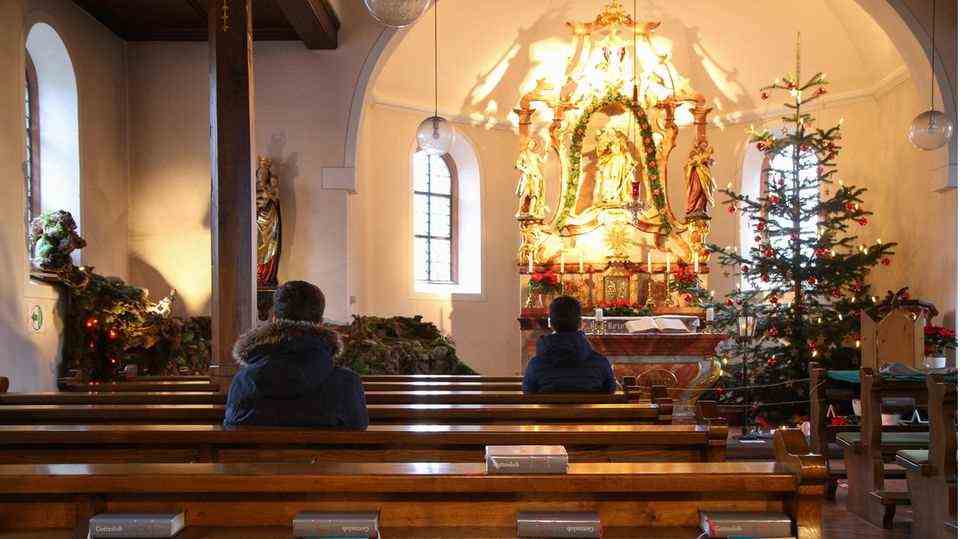Christmas 2021
Weird customs from all over the world: chicken wings and fear of the Christmas cat
The Japanese have traditionally celebrated Christmas indoors with fast food from Kentucky Fried Chicken since the 1970s.
© Tricky_Shark / Shutterstock.com
There are different traditions of celebrating Christmas around the world. Many of these customs exist in more than one country. However, some are truly unique – and at times a little quirky.
A Christmas tree is festively decorated, the entire family gathers for the feast and Santa Claus brings the gifts: Many Christmas customs are observed worldwide or differ only slightly from one another. However, some countries have their very own and sometimes bizarre traditions. A selection.
Fast food from KFC at Christmas
It may be a strange idea: Japanese people standing in line at the nearest Kentucky Fried Chicken store on Christmas Eve to grab the coveted “KFC special Christmas dinner”. In the land of the rising sun, where only a few Christians live, this is completely normal. Christmas is not an official holiday here and, according to the BBC, couples celebrate it more as a kind of second Valentine’s Day. Nevertheless, children can often look forward to gifts on Christmas Eve – and to reach into the cardboard box with fried chicken legs.
An estimated 3.6 million Japanese families indulge in fast food from KFC every year at Christmas time, and it all started with a brilliant marketing idea in the early 1970s. It was then that Takeshi Okawara, 77, the restaurant manager of Japan’s first branch, invented a “party bucket” that was only sold at Christmas to replace the feast that foreigners sorely missed at Christmas. In 1974 it was introduced nationwide under the name “Kurisumasu ni wa Kentakkii” or “Kentucky for Christmas” – and its consumption mutated into a unique Japanese Christmas tradition.
A Christmas cucumber that brings good luck
In the US homeland of KFC there is a tradition that will particularly astonish the Germans. In some states, according to the “New York Times”, when decorating the Christmas tree, the last thing that is hung up is an ornament in the form of a pickle and hides it as well as possible. The child who finds the cucumber first on Christmas morning – December 25th – receives an additional gift and is said to be very lucky the following year.
The tradition is said to be a gift from German immigrants who settled in particularly large numbers in the states of the Midwest – for example Wisconsin, Illinois and Minnesota. Funnily enough, very few people in this country have ever heard of the “Christmas pickle”. The well-known glass center in Lauscha, Thuringia, now produces around 50,000 cucumber ornaments every year.
On four rollers instead of four wheels for Christmas mass
South of the United States, people in the Venezuelan capital Caracas indulge in a particularly sporty Christmas tradition. On Christmas Eve they don’t walk or drive to mass, but put on their roller skates and drive them to the gates of the church. As “Metro” reported, it is still not entirely clear how the custom came about.
It may be an alternative to sledding, as this is virtually impossible in the country in northern South America thanks to its tropical climate. Roller skating at Christmas has become so popular in Caracas that the government of Venezuela is ensuring the safety of families rolling by by blocking the streets until around 8 a.m.
Fear of the Christmas cat
While South American children don’t really have to be afraid of traffic over Christmas, their Icelandic peers have a harder time. In the island state, Jólakötturinn, the Christmas cat, wanders around the houses after the festive season, looking for children to eat. According to the online travel guide “In Reykjavik”, the creature is “huge” and “moth-eaten” and belongs to the troll family of Grýla, the mother of the 13 Christmas brothers. On the 13 days before the festival, they each open to the people and then disappear again in the same order.
Only clothing protects against the hunger of the evil Jólakötturinn, which is why Icelandic children often find warm sweaters, pants, hats and the like under the Christmas tree. But only if they were good the year before.
Hidden brooms, a Catalan farmer in the manger and pudding on the ceiling
In another northern European country, people are not afraid of four-legged cats, but of witches and evil spirits who wreak havoc on Christmas night. According to the daily newspaper “Die Welt”, the Norwegians hide their brooms and mops in good time so that the uninvited guests cannot use them as a flight instrument.
Much of Christmas Eve in Spain and Slovakia revolves around happiness, not fear – albeit in quite different forms. In Catalonia, according to the BR, the so-called caganer is also hiding in the traditional nativity scene between Jesus, Mary, Joseph and the three wise men. The figure is a man in Catalan peasant costume who is doing his business. It serves as a good luck charm for the farmer of the crib and for those who discover the caganer.
In Central Europe, on the other hand, a delicious dessert determines how lucky a family can be over the next twelve months: the Slovak Loksa pudding. The oldest male family member traditionally deserves the honor of throwing him against the ceiling with a spoon. The more pudding that sticks to the end, the greater the happiness.



